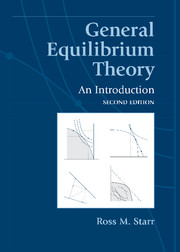Book contents
- Frontmatter
- Contents
- List of illustrations
- Introduction to the second edition
- Preface to the second edition
- Preface to the first edition
- Table of notation
- Table of assumptions
- A General equilibrium theory: Getting acquainted
- B Mathematics
- C An economy with bounded production technology and supply and demand functions
- D An economy with unbounded production technology and supply and demand functions
- E Welfare economics and the scope of markets
- F Bargaining and equilibrium: The core
- G An economy with supply and demand correspondences
- H Standing on the shoulders of giants
- 26 Next steps
- 27 Summary and conclusion
- Bibliography
- Index
26 - Next steps
from H - Standing on the shoulders of giants
Published online by Cambridge University Press: 05 June 2012
- Frontmatter
- Contents
- List of illustrations
- Introduction to the second edition
- Preface to the second edition
- Preface to the first edition
- Table of notation
- Table of assumptions
- A General equilibrium theory: Getting acquainted
- B Mathematics
- C An economy with bounded production technology and supply and demand functions
- D An economy with unbounded production technology and supply and demand functions
- E Welfare economics and the scope of markets
- F Bargaining and equilibrium: The core
- G An economy with supply and demand correspondences
- H Standing on the shoulders of giants
- 26 Next steps
- 27 Summary and conclusion
- Bibliography
- Index
Summary
This chapter surveys very briefly developments in the general equilibrium theory of the last several decades. There is no room here for the richness and detail that these topics merit. They each have a population of books and articles of their own. Nevertheless, even a beginning student of general equilibrium theory can appreciate a notion of the scope of the generalizations.
Large economies
Chapters 22 and 25 emphasized the importance of large numbers of households in the economy. As the economy becomes large, the core converges to the competitive equilibrium allocations (Theorem 22.2), and, indeed, this result is true even without the assumption of convex preferences (Theorem 22.3). Further – concentrating on the limiting behavior of the economy as the economy becomes large – the assumptions of convex technology and convex preferences are no longer required for existence of competitive equilibrium (Theorem 25.1).
These results are stated as limiting behavior as the economy becomes large. The alternative is to state the results directly for a large economy – an economy with an infinite number of households. One way to do this is to think of the set of households as the points on the unit interval [0, 1], an uncountable infinity of households. Then, instead of summing the demands of the households to find total demand, it is appropriate to integrate the demand function over the interval. It is important to emphasize that each point in the interval is negligible (has wealth infinitesimally small compared to the total).
- Type
- Chapter
- Information
- General Equilibrium TheoryAn Introduction, pp. 325 - 331Publisher: Cambridge University PressPrint publication year: 2011



